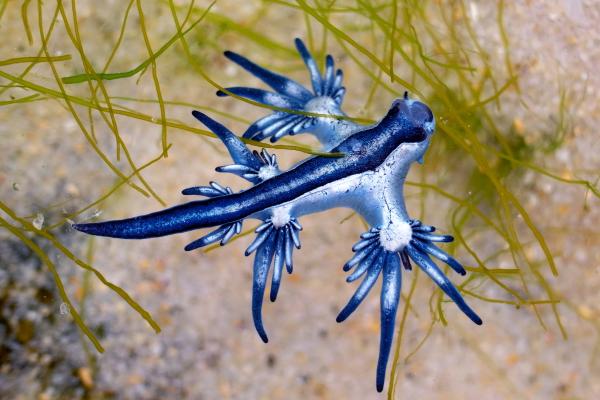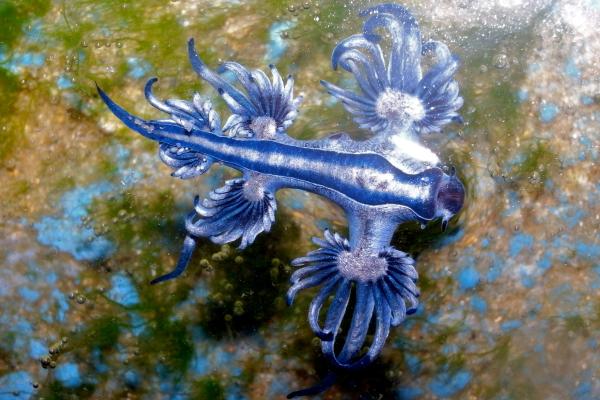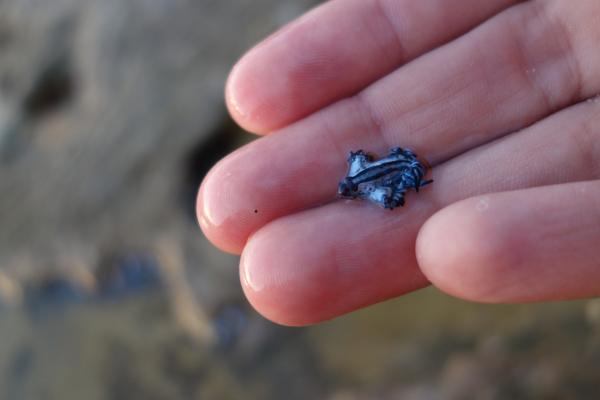Size: The blue dragon can grow up to 4 centimeters in length.
Coloration: It has a deep blue dorsal side, with a silvery underside marked by two darker blue lines running from head to tail.
Body: Elongated body with a belly lined in blue and silver-gray horizontal stripes.
Head: Positioned terminally, featuring a dark blue mouth and two visible oral appendages.
Jaws: Highly developed with zipper-like denticles that close tightly, aiding in prey capture.
Tongue: Equipped with denticles, specialized for scraping food.
Appendages: It possesses six branching cerata that store venom extracted from consumed jellyfish. Additionally, it has rhinophores—cone-shaped sensory organs located on the dorsal part of the head, colored silver-gray.

The blue dragon is primarily found in temperate and tropical waters worldwide. It floats at the water's surface, kept buoyant by a gas bubble in its stomach. This adaptation allows it to drift with ocean currents and wind in search of food.
Though widespread across oceans, it is rarely seen near shores unless pushed inland by strong currents. Its sightings are most frequent in the Atlantic Ocean and have been reported off the coasts of South Africa, Mozambique, Barbados, Europe, and Australia.

This species has a specialized diet that mainly includes jellyfish and hydrozoans, particularly the Portuguese man o' war (Physalia physalis). It feeds on these venomous creatures and stores their stinging cells (nematocysts) within its cerata. These not only provide nutrition but also serve as a potent defense mechanism against predators.
The blue dragon uses tiny tentacles near its mouth to latch onto prey, enabling it to consume even dangerous marine organisms. This feeding strategy plays a vital ecological role, as it helps control Portuguese man o' war populations—alongside sea turtles and ocean sunfish.

Blue dragons are hermaphrodites, meaning each individual has both male and female reproductive organs. During mating, two individuals face each other and extend their penises (which can reach over 60 mm) to exchange sperm. This process lasts about one hour.
After mating, the pair deposits between 10 to 30 eggs in clusters that float on the ocean surface. The eggs hatch in about three days into veliger larvae—free-floating juveniles that eventually mature into adult nudibranchs.
Interestingly, eggs have also been observed attached to prey items, providing both shelter and a food source for the emerging larvae—acting as a form of "nursery."
Predatory: It uses and stores venom from its prey to hunt or defend itself.
Air-buoyant: Swallows air to float and drift across tropical seas, often traveling great distances.
Upside-down flotation: Floats belly-up, aiding in camouflage against the ocean’s surface.
Face-to-face mating: Unlike most gastropods, it mates frontally and exhibits specialized reproductive structures that enable this behavior.
Yes. While normally found offshore, the blue dragon can occasionally be washed ashore by strong winds or tides, increasing the risk of human contact—especially when they gather in large groups known as "blue fleets."
It possesses stinging cells called cnidocytes, stored in cnidosacs located at the tips of its cerata. By consuming jellyfish like the Portuguese man o’ war, it harvests and repurposes their venom, becoming even more venomous than its prey.

Capture: Uses serrated teeth to bite prey tentacles and absorb nematocysts.
Storage: Stores the nematocysts in the ceratal sacs for later use.
Discharge: When touched by a predator or human, it releases these stinging cells, injecting venom.
Symptoms in humans include a burning sensation, intense pain, nausea, vomiting, acute allergic dermatitis, and, in rare cases, anaphylactic shock or fainting. Post-inflammatory hyperpigmentation can leave visible skin discoloration even after the initial reaction subsides.
Now that you’ve learned about the fascinating Glaucus atlanticus, you might also enjoy our article on the most venomous animals in the world.
animal tags: glaucus atlanticus
We created this article in conjunction with AI technology, then made sure it was fact-checked and edited by a Animals Top editor.